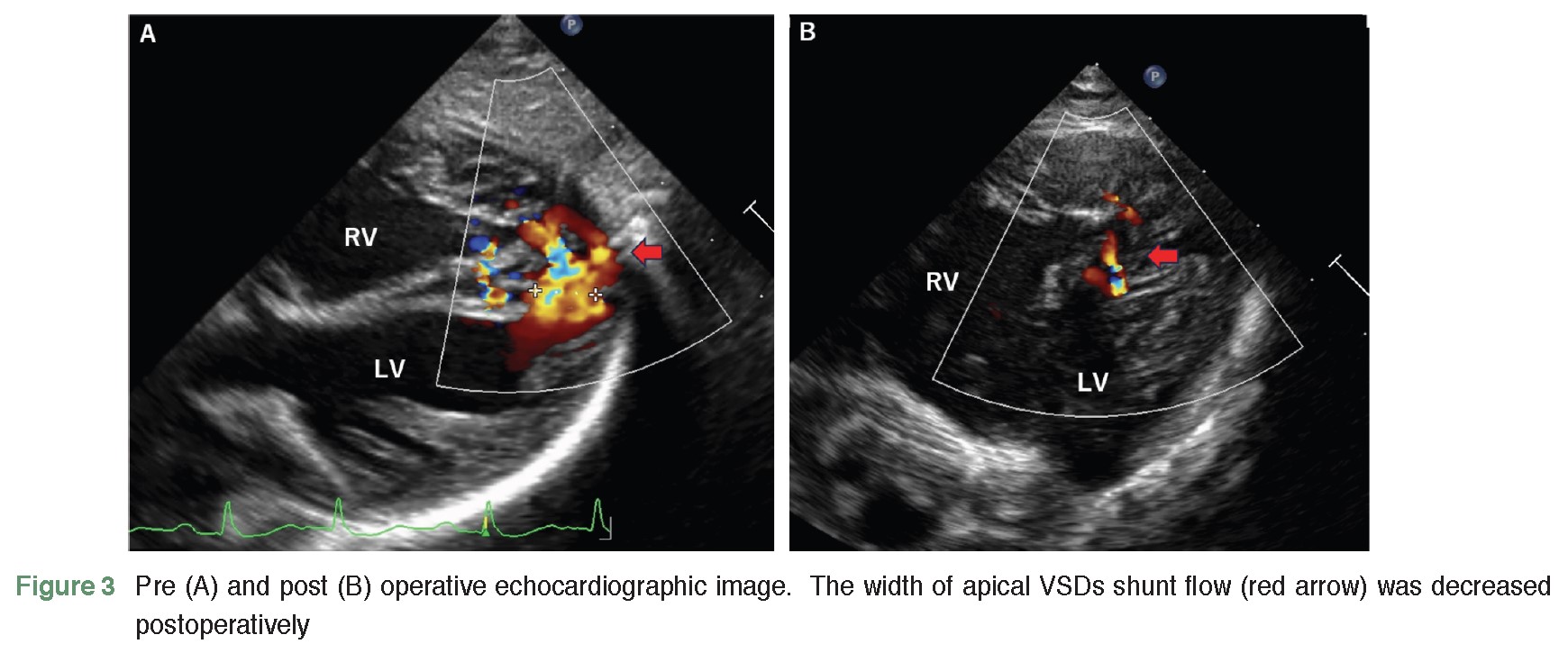Felt Sandwich Exclusion for Apical Multiple Muscular Ventricular Septal Defects
Keywords:
Congenital heart disease, Acyanotic heart disease, Multiple ventricular septal defectsAbstract
Background: Apical multiple muscular ventricular septal defects (VSDs) are difficult to visualize, and closing these VSDs is technically troublesome. For these reasons, the surgical outcome of the lesion is unsatisfactory. Some surgical techniques have been reported to improve the outcome, but they are not definitive.
Case presentation: We present a 5-month-old infant diagnosed with atrial septal defect (ASD) and multiple muscular and perimembranous VSDs. Pulmonary hypertension (PH) due to high pulmonary blood flow was also observed. Symptoms of this patient were dyspnea and poor weight gain. The surgical treatment was needed for the patient. In the first operation during the infantile period, the patient received closure of the perimembranous and muscular VSDs through the right atrium. ASD closure was also performed. However, postoperative pulmonary blood flow was not decreased compared with that before the operation, and PH was not improved. In addition to these lesions, tricuspid valve insufficiency was also observed after the operation. Postoperative computed tomography (CT) showed channels of apical muscular VSDs in the apex of the right ventricle. Surgical re-intervention was planned to reduce pulmonary blood flow. In the second operation, the exclusion of apex muscular VSDs using the felt sandwich exclusion technique and tricuspid valve repair was performed. After closing multiple muscular VSDs during the operation, pulmonary blood flow was significantly decreased, and PH was improved as well. After the second operation, postoperative echocardiography and catheter examination showed decreased VSD shunt and reduced pulmonary blood flow, resulting in improved PH.
Conclusion: Felt sandwich exclusion for apical multiple muscular ventricular septal defects may be one of the surgical options for apical muscular ventricular sepal defects.
References
Kitagawa T, Durham LA 3rd, Mosca RS, et al. Techniques and results in the management of multiple ventricular septal defects. J Thorac Cardiovasc Surg. 1998;115(4):848-56. doi: 10.1016/S0022-5223(98)70366-6.
Ootaki Y, Yamaguchi M, Yoshimura N, et al. Surgical management of trabecular ventricular septal defects: the sandwich technique. J Thorac Cardiovasc Surg. 2003;125(3):508-12. doi: 10.1067/mtc.2003.56.
Yoshimura N, Matsuhisa H, Otaka S, et al. Surgical management of multiple ventricular septal defects: the role of the felt sandwich technique. J Thorac Cardiovasc Surg. 2009;137(4):924-8. doi: 10.1016/j.jtcvs.2008.08.055.
Okubo M, Benson LN, Nykanen D, et al. Outcomes of intraoperative device closure of muscular ventricular septal defects. Ann Thorac Surg. 2001;72(2):416-23. doi: 10.1016/s0003-4975(01)02829-6.
Myhre U, Duncan BW, Mee RB, et al. Apical right ventriculotomy for closure of apical ventricular septal defects. Ann Thorac Surg. 2004;78(1):204-8. doi: 10.1016/j.athoracsur.2003.12.054.

Downloads
Published
How to Cite
Issue
Section
License
Copyright (c) 2024 The Royal College of Surgeons of Thailand

This work is licensed under a Creative Commons Attribution-NonCommercial-NoDerivatives 4.0 International License.
Articles must be contributed solely to The Thai Journal of Surgery and when published become the property of the Royal College of Surgeons of Thailand. The Royal College of Surgeons of Thailand reserves copyright on all published materials and such materials may not be reproduced in any form without the written permission.


